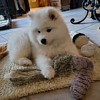Posted 5 months ago
 glasfreund
glasfreund
(37 items)
In the aforementioned sales or pattern book “Fantasie-Artikel aus Farbenglas” from c1897, plate 5 shows Olympia glasses with ornamental decors in gilded relief enamel (“Olympia – grün mit matten Metallschimmer”). They can undoubtedly be attributed to the Loetz glassworks. On the same plate there are also historizing glasses with a white matt iridescent background and floral paintings in relief enamel with gold, some with coloured flower garlands. The gold rims at the base and the rim are also common. When I first saw these objects, I thought of the Josephinenhütte as a possible producer. Now, after more intensive study of the shapes and even with a proven decoration, I can say that these glasses also come from the Loetz glassworks. The pattern book also gives the decoration description: “Zephyr – opalisierend mit matten Metallschimmer” and “Zephyr - opal blanc metalisé”.
Loetz probably used “Zephyr” – also spelled “Zephir” – both as a decor and as a color name. This coincides with “Olympia” as the name for the greenish glass mass colored with uranium and as a generic term for all decorated glasses with Olympia as the base glass. Zephyr as a whitish color by Loetz is not unknown. “Zephyr with blue stripes and spots” is a decor that Koloman Moser used for his designs for the Viennese company Bakalowits Söhne, among others.
I will have to leave it to further research to find out whether the Zephyr glasses are also UV-reactive like the color on later glasses. Unfortunately, I do not own a sample with the now verifiable decor.
Fortunately, the attribution of the decor is also confirmed by an entry on at least one paper pattern. Pattern I-6908 lists “zephyr” and “zephyr glatt”. On other patterns we find “zephyr ribbed”, “zephyr Chiné” and “zephyr Martelé”. So, zephyr primarily stands for the color mass.
There are also clear similarities in the shapes, albeit few, with the preserved patterns as well as with glasses with other Loetz decorations. Vase C 123 corresponds in size and shape to pattern I-6907 and vase C 130 to pattern I-6908 mentioned above. The fanned vase C 134 corresponds to pattern I-7854, although it is significantly larger. It is not unusual for Loetz to later include individual shapes in the production program in modified sizes.
An additional indication of the creatorship of Johann Lötz Witwe is provided by decor example I/389 on the Loetz website (loetz.com - decors). The characteristic Loetz inscription on the underside can be found on a Zephyr glass that corresponds completely to those in the sample catalog.
Just one year after the catalog went to press, Loetz turned to Art Nouveau glass. Although we can still find plenty of examples of the design and decorative language of historicism after 1898, Loetz quite consistently removed many of the previously characteristic types of glass from the range. I think that with the change in taste at the turn of the century, many Zephyr glasses have disappeared forever from their owners' display cabinets and cupboards and we would need a lot of luck today to be able to integrate them into our Loetz collections.
About the pictures:
The Zephyr glasses shown in the catalog “Fantasie-Artikel aus Farbenglas”.
Matching shapes: I-6908 and I-6907.
Zephyr glass with decoration number I/389 (source: loetz.com)



























What category is this posted in? I do not see it popping up under Antique Loetz Art Glass/Show & Tell
Oh thanks, didn't notice. Now recategorized. Still an apprentice in Collectots Weekly :-).